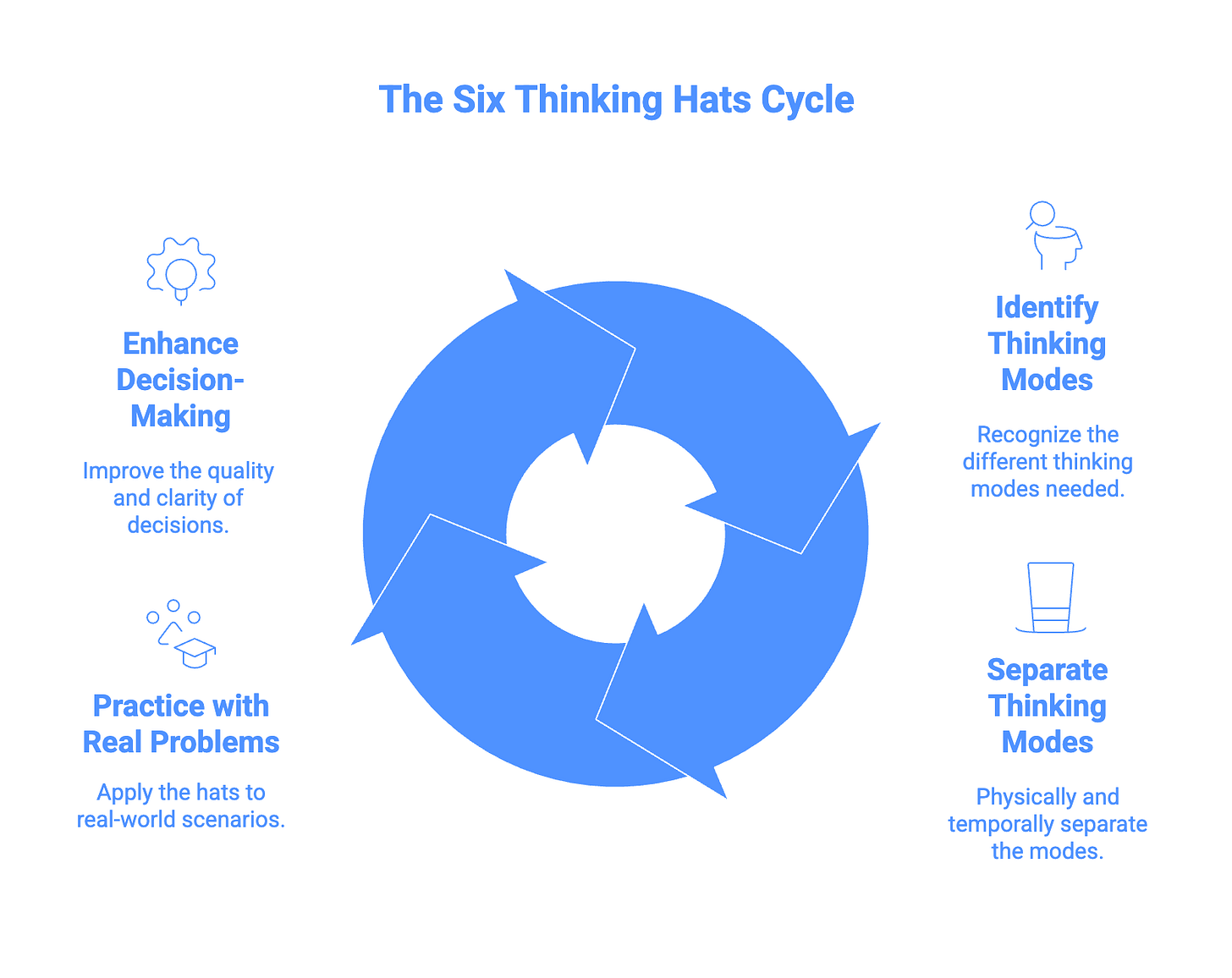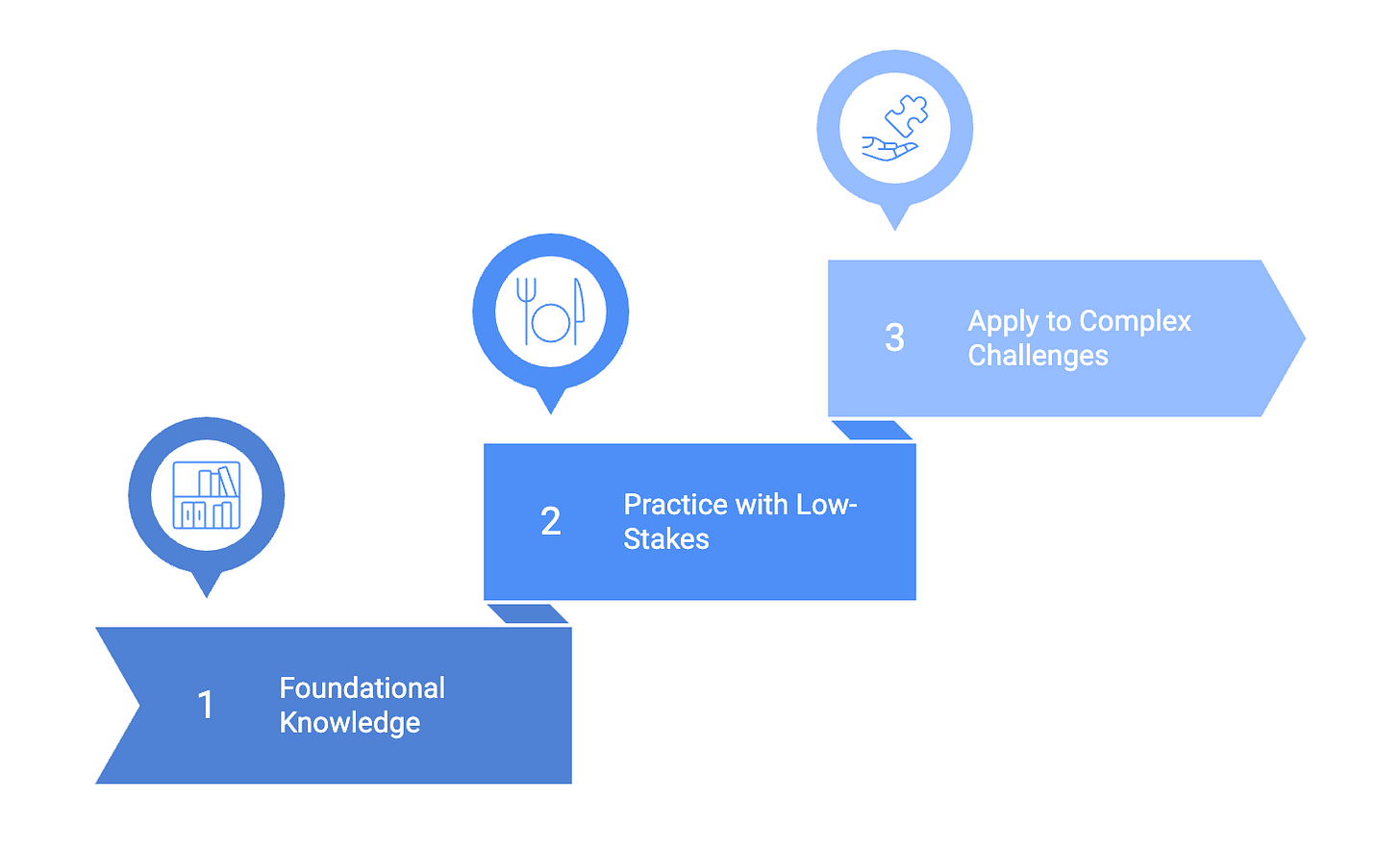From Confused Guessing to Confident Choosing in Any Situation
How six simple thinking steps eliminate doubt and second-guessing
Hi Kwik Brain!
You're about to learn why 91% of people make terrible decisions - and the concrete system that fixes this problem. By the end of this article, you'll understand how to gather complete information before making any important choice, eliminating the "bounded rationality" that sabotages most decision-making.
Here's what's actually happening in your brain when you make bad decisions. You're trying to analyze problems with incomplete information. Researchers call this bounded rationality - making choices based on simplified mental models rather than concrete reality. Studies show this creates literal "mental ulcers" in organizations, with 30% of complexity stemming from efficiency pressures that force premature analysis.
The collaboration crisis that sparked a solution
Edward de Bono created the Six Thinking Hats in 1985 after watching countless meetings collapse into chaos. People argued past each other because everyone was thinking in different modes simultaneously. Facts mixed with emotions. Risks tangled with benefits. Creative ideas got shot down by critical analysis before they could develop.
De Bono realized the problem wasn't bad people or poor communication. The problem was trying to think in six different ways at once. Like trying to play six instruments simultaneously, it produces noise instead of music.
His solution wasn't another abstract framework. It was a concrete system for separating different types of thinking physically and temporally.
But here's what most people miss: the hats aren't mental concepts you "understand." They're experiential tools you practice with real problems.
Why knowing about the hats isn't the same as using them
Augustine observed something crucial about knowledge: "When no one asks me, I know; if I wish to explain it to one that asketh, I know not." There's a massive gap between intellectual understanding and practical application.
You can read about the six hats and think you "get it." But until you've used them to solve actual problems - with real stakes, real complexity, and real consequences - you don't actually know how they work.
Research confirms this distinction. Memory of experience differs fundamentally from verbalized knowledge. Studies show that people who practice decision-making methods with concrete scenarios achieve 79.18% better outcomes than those who just study the concepts.
Your hands-on thinking toolkit
Here's how each hat works when applied to real problems - not just explained as abstract concepts:
🤍 White hat: physical evidence gathering Don't just "focus on facts." Literally collect documents, data sheets, measurements, and evidence before starting analysis. For complex decisions, create a physical file of all available information. Studies show concrete processing leads to better outcomes than abstract rumination.
❤️ Red hat: embodied gut checking Instead of just "listening to emotions," pause and physically check your body's response. Where do you feel tension? What's your energy level when considering each option? Emotional intelligence research shows physical awareness produces more accurate intuitive insights.
🖤 Black hat: real-world failure testing Rather than just "thinking critically," test ideas in small, controlled scenarios first. Build prototypes. Run pilot programs. Interview people who've tried similar approaches. Concrete testing reveals failure points that purely mental analysis misses.
💛 Yellow hat: evidence-based optimism Don't just "think positively." Gather actual examples of similar successes, research supporting evidence, and concrete benefits you can measure. Optimism grounded in reality performs better than wishful thinking.
💚 Green hat: physical creative tools Skip the "brainstorming session." Use sketches, models, prototypes, and hands-on experimentation. Research shows physical creative processes generate more innovative solutions than purely mental exercises.
💙 Blue hat: structured process management Beyond just "managing discussion," create actual agendas, timelines, and measurable checkpoints. Document what each hat session produces. Track which approaches work for different problem types.
The supply chain reality test
Want to see how this works with something incredibly complex? Take any object near you and trace its complete origin story.
That coffee mug represents an immense network of human cooperation. Clay or ceramic materials mined from specific locations. Manufacturing processes requiring specialized equipment. Transportation systems spanning continents. Distribution networks connecting thousands of people and organizations.
Each hat reveals different aspects of this complexity:
White hat uncovers data gaps: Where exactly was this made? What were the environmental costs?
Black hat identifies potential failure points: What happens if one supplier fails?
Green hat generates alternatives: How could this system work differently?
Yellow hat highlights collaborative achievements: How do millions of strangers coordinate successfully?
Supply chain research shows that 48% of complexity comes from efficiency pressures - people rushing decisions without understanding interconnections. The six-hat system forces you to slow down and gather complete information first.
The three-phase implementation system
Phase 1: Start with foundational knowledge gathering. Never apply any hat to problems you don't understand deeply. Spend 2-3 times longer than feels comfortable gathering concrete information. Research shows 91.08% accuracy improvement when foundational knowledge precedes analysis.
Phase 2: Practice with low-stakes decisions first. Use the hats on everyday choices before tackling major problems. Which restaurant for dinner? Which route to work? Which movie to watch? Build your concrete experience base gradually.
Phase 3: Apply to complex, interconnected challenges. Only after mastering simple applications should you use the hats for major decisions. Complex problems require deep familiarity with how each hat actually functions in practice.
What the research reveals about limitations
Here's what the studies don't tell you: this method fails when people treat it as a magic formula rather than a skill requiring practice.
The anti-psychiatry research shows how ideas become weaponized when separated from their historical context. The KGB took legitimate critiques of Soviet psychiatric abuse and turned them into weapons against Western institutions. The same thing happens when people use the six hats without understanding their collaborative origins.
Epistemic humility research shows that acknowledging limitations actually improves performance. The six hats work best for collaborative problems requiring multiple perspectives. They're less effective for purely technical decisions or situations requiring immediate action.
Your next concrete step
Choose one decision you're currently facing. Not a simple choice - pick something genuinely complex with multiple stakeholders and unclear outcomes.
Start with foundational knowledge gathering. What concrete information are you missing? Spend twice as long as feels comfortable collecting actual data, documents, and evidence.
Only then begin the hat rotation. Set a timer for each hat session. Document what you discover. Notice the gap between what you thought you knew and what you actually found.
Research shows delayed memory enhancement effects appearing six weeks after foundational learning. The real benefits of this system emerge through repeated practice with progressively more complex problems.
The difference between people who make consistently good decisions and those who don't isn't intelligence. It's having concrete systems for gathering complete information before choosing.
Your six-hat toolkit is ready. Which real problem will you use it on first?
Ready to dive deeper into evidence-based decision-making systems? Explore more research-backed cognitive tools and practical implementation strategies in our complete archive.






